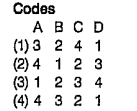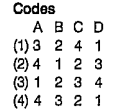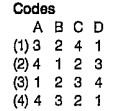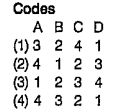The correct pair(s) of the ambident nucleophiles is (are) :
(A) AgCN/KCN
(B) RCOOAg/RCOOK
(C ) AgNO2/KNO2
(D) AgI/KI
(A) only
(B) only
(A) and (C ) only
(B) and (C ) only
To determine the correct pair(s) of ambident nucleophiles from the given options, we need to analyze each pair and identify if they have two different binding sites.
1. Understanding Ambident Nucleophiles:
- Ambident nucleophiles are species that can donate electrons from two different atoms or sites. For example, a nucleophile can have both a negative charge on one atom and a lone pair on another.
2. Analyzing Option (A): AgCN/KCN:
- KCN: This is an ionic compound. The cyanide ion (CN⁻) has a negative charge on carbon (C). Therefore, it can act as a nucleophile through the carbon atom.
- AgCN: This is a covalent compound. In this case, the nitrogen (N) can donate its lone pair, acting as a nucleophile.
- Conclusion: Both AgCN and KCN have two different binding sites (C in KCN and N in AgCN). Thus, this option is valid.
3. Analyzing Option (B): RCOOAg/RCOOK:
- RCOOK: This is an ionic compound. The carboxylate ion (RCOO⁻) has a negative charge on one of the oxygen atoms. It can act as a nucleophile through the negatively charged oxygen.
- RCOOAg: This is a covalent compound. The nitrogen atom can donate its lone pair, acting as a nucleophile.
- Conclusion: Both RCOOAg and RCOOK have two different binding sites (O in RCOOK and N in RCOOAg). Thus, this option is valid.
4. Analyzing Option (C): AgNO2/KNO2:
- KNO2: This is an ionic compound. The nitrite ion (NO2⁻) can act as a nucleophile through the negatively charged oxygen atom.
- AgNO2: This is a covalent compound. The nitrogen atom can donate its lone pair, acting as a nucleophile.
- Conclusion: Both AgNO2 and KNO2 have two different binding sites (O in KNO2 and N in AgNO2). Thus, this option is valid.
5. Analyzing Option (D): AgI/KI:
- KI: This is an ionic compound. The iodide ion (I⁻) is the nucleophile here.
- AgI: This is a covalent compound. The iodide ion (I⁻) is the only nucleophile here as well.
- Conclusion: Both AgI and KI do not have two different binding sites; they both rely on the same nucleophile (I⁻). Thus, this option is invalid.
Final Conclusion:
The correct pairs of ambident nucleophiles are:
- (A) AgCN/KCN
- (B) RCOOAg/RCOOK
- (C) AgNO2/KNO2
- Ambident nucleophiles are species that can donate electrons from two different atoms or sites. For example, a nucleophile can have both a negative charge on one atom and a lone pair on another.
- KCN: This is an ionic compound. The cyanide ion (CN⁻) has a negative charge on carbon (C). Therefore, it can act as a nucleophile through the carbon atom.
- AgCN: This is a covalent compound. In this case, the nitrogen (N) can donate its lone pair, acting as a nucleophile.
- Conclusion: Both AgCN and KCN have two different binding sites (C in KCN and N in AgCN). Thus, this option is valid.
- RCOOK: This is an ionic compound. The carboxylate ion (RCOO⁻) has a negative charge on one of the oxygen atoms. It can act as a nucleophile through the negatively charged oxygen.
- RCOOAg: This is a covalent compound. The nitrogen atom can donate its lone pair, acting as a nucleophile.
- Conclusion: Both RCOOAg and RCOOK have two different binding sites (O in RCOOK and N in RCOOAg). Thus, this option is valid.
- KNO2: This is an ionic compound. The nitrite ion (NO2⁻) can act as a nucleophile through the negatively charged oxygen atom.
- AgNO2: This is a covalent compound. The nitrogen atom can donate its lone pair, acting as a nucleophile.
- Conclusion: Both AgNO2 and KNO2 have two different binding sites (O in KNO2 and N in AgNO2). Thus, this option is valid.
- KI: This is an ionic compound. The iodide ion (I⁻) is the nucleophile here.
- AgI: This is a covalent compound. The iodide ion (I⁻) is the only nucleophile here as well.
- Conclusion: Both AgI and KI do not have two different binding sites; they both rely on the same nucleophile (I⁻). Thus, this option is invalid.
The correct pairs of ambident nucleophiles are:
- (A) AgCN/KCN
- (B) RCOOAg/RCOOK
- (C) AgNO2/KNO2
Similar Questions
Ambident Nucleophiles are
1. AgCN,KCN
2. AgNO2, KNO2
3. KI,AgI
4. RCOONa, RCOOK
View SolutionAlkylhalides have polar C-X bond and undergo nucleophilic substitution reactions. These give a variety of products with nucleophiles such as −OH,−OR,−NH2,−CN,−NC,−NO2,−ONO,RCOO−, etc. They undergo mainly two types of nucleophilic substitution reactions, SN1 and SN2. SN1 reactions are two steps reactions which proceed through the formation of carbocations while SN2 reactions are one step reaction which proceeds through the formation of transition state. The stability of carbocation and transition state determine the reactivity of alkyl halides.
Write the main products A and B in the following reaction.
AKNO2←−−−CH3CH2BrAgNO2−−−→B.
View Solution
Knowledge Check
The increasing order of nucleophilicity of the following nucleophiles is:
(a) CH3CO−2 (b) H2O (c) CH3SO−3 (d) OHA(b)<(c)<(d)<(a)B(d)<(a)<(c)<(b)C(b)<(c)<(a)<(d)D(a)<(d)<(c)<(b)Match the correct pairs of plant and its pollinating agent and choose the correct option.

a) A -3, B -2 , C -4 . D - 1.
b) A - 4 , B - 1, C - 2. D -3.
c) A - 1, B - 2, C - 3. D - 4.
d) A -4, B - 3, C -2. D - 1.
A B
B C
C D
D
Consider the following salts which one(s) when dissolved in water produces acidic solution.
(a)KHSO4 , (b)NaCN
(c)NH4Cl , (d)KNO3Aa and bBb and cCb and dDa and c
Alkylhalides have polar C-X bond and undergo nucleophilic substitution reactions. These give a variety of products with nucleophiles such as −OH,−OR,−NH2,−CN,−NC,−NO2,−ONO,RCOO−, etc. They undergo mainly two types of nucleophilic substitution reactions, SN1 and SN2. SN1 reactions are two steps reactions which proceed through the formation of carbocations while SN2 reactions are one step reaction which proceeds through the formation of transition state. The stability of carbocation and transition state determine the reactivity of alkyl halides.
Write the main products A and B in the following reaction.
AKNO2←−−−CH3CH2BrAgNO2−−−→B.
View SolutionWhat happens when SiO2 is reacted with following ?
(a) KOH, (b) CaCO2, (c ) KNO3, (d) HF
(e ) Coke
View SolutionWhich compound for each of the following pairs is more ionic and why ?
a. BeBr2 or MgBr2 , b. PbCl2 or PbCl4
c. AgBr or AgI , d. CuO or CuS
View SolutionWhich of the following reagent is used to test the purity of chloroform?
(A) AgNO3
(B) AgCl
(C) CCl4
(D) CCl2F2
View SolutionIf asinA=K, then the area of DeltaA B C in terms of K and sines of the angles is K24s∈A s∈B s∈C (b) K22s∈A s∈B s∈C 2K2s∈A s∈B sin(A+B) (d) none
View Solution
